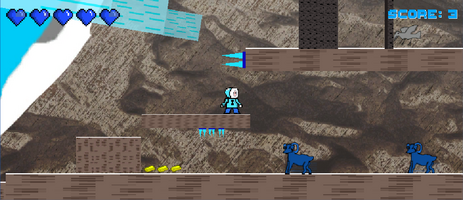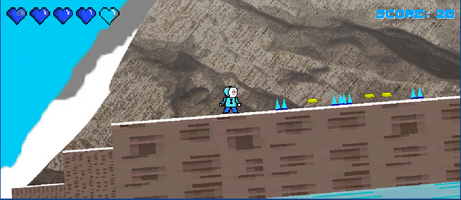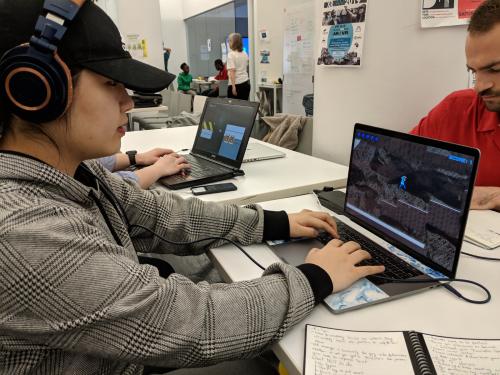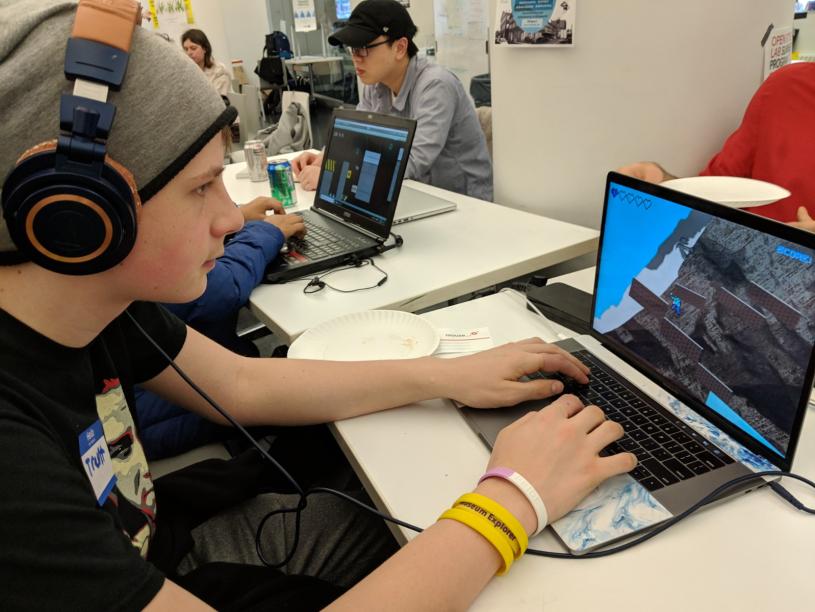Postmortem



Introduction (Costas):
To begin with, the project required of us to create a 2D side-scroller/classic platformer which draws from games such as Super Mario Bros, Super Meat Boy and Megaman to name but a few. In fact, the project requirement depended heavily on creating an intuitive and escalating - in terms of difficulty - game were the initial level guides the player through the contents of the game to teach them what to expect and how the game works. The following two levels required would have to contain what the first level taught the player in different ways.
In terms of the concept, our group had to develop an original mechanic and theme that would fit in well with the game. Indeed, it was challenging to come up with a core concept that had not been explored before, especially in the field of classic 2D platformers. Whether it was based on the jump mechanic or on how the level itself works, we had to develop something that took into account how pre-existing games work but to add our own touch to it.
As such, our group decided to follow the theme of climbing a mountain and base our ideas off of that core concept; our levels would have to be ascending in a way to make the player feel as though they are ascending a mountain. As a result, we created diagonally ascending levels which guide the player upwards with the view of a mountain behind them, in a bid to inform the player when they reach the mountain summit
What Went Wrong (Costas):
In going through the various iterations of our game, we encountered numerous problems and constraints that meant we would have to look at things differently in our game and perhaps even to navigate to different directions.
A major problem that we encountered after having our first playtest was due to the fact that our game lacked something original. Indeed, it had been likened to a ‘Super Mario Bros World 1-1’ clone, as the layout of the level we presented appeared to be a duplicate of that famous first level of Super Mario Bros. This was a serious problem as we were failing in the most important prerequisite of this project; to develop an original take on the genre of 2D classic platformers.
Another serious issue we had right from the get go was with our enemy collisions and the way they took damage. In fact, the player had to perform a strange jump and hit technique on enemies in order to kill them, which would not always work. As a result, hitting an enemy head on would not kill them and would only damage and annoy the player. This issue continued to persist until the most recent iteration of our game and a variation of it still persists, in that one hit will kill any enemy no matter what their health may be.
Continuing, we noticed in various playtests that a knockback effect that we had placed on environmental hazards was working quite strangely. In fact, depending on how the player collided with the hitbox of the hazard or enemy, there was a chance that they would get skyrocketed out of the level or thrown through walls and platforms. This was a big inhibition as it meant the player may land anywhere in the three levels as they were designed to be ascending upward and were all part of the same scene. As such, reducing or removing the knockback had to be considered.
Finally, we decided to include spike balls that would fall from up high and damage the player if they contact with him/her. As such, we had problems with the timing and destruction of the instantiated balls; too many of them spawning would slow down the game and a slow spawning would not make sense to the player. It was quite a struggle to try to find the sweet time spot for each spikeball generator and when they should start spawning balls and at what time ratio. Furthermore, the spike balls for some reason stopped damaging the player and would simply inhibit movement. This meant we had to find a way to fix this and when we did how damage would affect the timing of the balls so as not to make the game impossibly hard. Through the Playtech event we saw that if players collected too much gold too early, then it did not permit them to pass certain parts of the early game level due to the fact that it was not designed to allow for a decreased Jump Power. As such, we had to go in and solve that issue after the playtests.
What Went Right (Shantanu):
In addition to having quite a few things go wrong, there were also several things in the game that went right.
In terms of what went right, the first thing that went right was creating the look and feel of the environment through the sprites. Each different visual asset created and put in felt like part of the environment and matched the theme of the game, each object is distinguishable enough that players can tell what’s what and can figure out what objects to avoid and what objects will benefit them. The sprites also animate well for the player and the audiovisual feedback of the player’s actions work.
The second thing that works well are the controls and general feel of the game. The game’s controls are simple, responsive, and all serve a purpose for the player. From feedback given on the playtests, the game is fun to play and the controls are a big part of that. There is also a sense of difficulty to the game and it’s not easy to just run through to get to the end, there’s a fair amount of obstacles to avoid and that makes the game more challenging for players.
The third thing that went right was the UI, the health and score indicators seemed to get praise from the playtesters who played the game and they said that gave them more incentive to collect gold. Also, the addition of the controls on the title screen would lead to little confusion on the end of the players as to what buttons did what.
The final thing that went right was the risk/reward system that we put in place, where, if the player collects too much gold, they increase in weight making it more difficult for them to do the platforming whenever they are jumping around. This added a layer of challenge to the game that was not previously there and made the gold collection system far riskier as the player could potentially lose if they actually sought out to collect all the gold, it also made players have to think creatively.
On a side note, through the Playtech experience, we saw that playtesters were enjoying a hidden mechanic which allowed them to double jump through platforms in a faster pace, allowing them to speed run parts of the game. We then decided that this mechanic provided an interesting aspect to the game and got players hooked on it even more.
What We Learned (Shantanu):
Both Shantanu and Costas learned a fair amount on this project. Shantanu mainly learned about professional 2D asset creation for a purpose. While he has taken 2D asset creation courses, he’s never had to create them for a specific project at as fast a pace as he did, this was an interesting learning curve for him and the fact that he got to practice 2D asset creation in this project gives him some insight as to what 2D asset creation might be like in an occupational setting with paid salary.
The second thing Shantanu learned during this project was how to do sound for players, while he has done sound before for games, all of it has mainly been background music, never sound effects, but in this project, he created the sound effects and soundtrack and did the coding for the sound effects as well. This isn’t something that Shantanu has done before, therefore, as his first time learning how to do this, there was some difficulty, but it was still a learning experience for him. Next time, if I’d do something differently, I’d try to stick to one consistent resource to learn the information I’d need. In addition, I’d try to add as much polish to the game’s graphics as I can.
Costas learned some additional coding principles, he was able to code much more efficiently through the additional coding methods that he learned. This would help him avoid getting stuck following coding paths that wouldn’t work while coding and would help him finish the scripts very easily. In addition, he also learned how to design levels far more efficiently and organize the levels by placing items in logical areas. This helped us decided the best way to create our platformed levels and in addition, made it far easier to code our project since we would be able to minimize the amount of repetitive coding we would need.
Both of us learned how to do some additional tricks with 2D side-scrolling. Probably the most apparent one was the parallax scrolling effect, in which the background, foreground, and middle ground move at different speeds to simulate a depth of field effect, which we used to make it feel as if the player is moving forward.



Get Ice Brink
Ice Brink
Classic 2D sidescroller/platformer with a mountainous twist by
| Status | Released |
| Authors | Consc, Shantanu Nair |
| Genre | Adventure |
Leave a comment
Log in with itch.io to leave a comment.